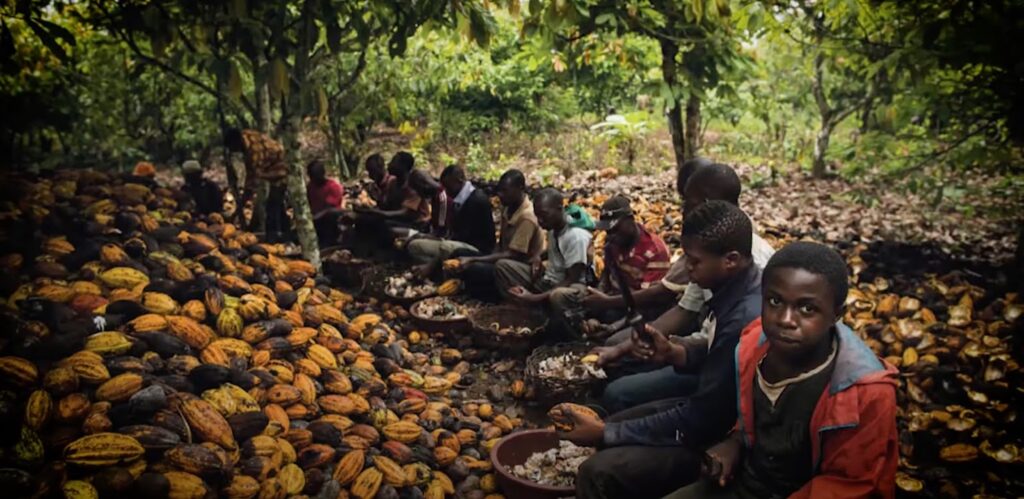Hershey’s, Nestlé, and Mars are names synonymous with chocolate delights that fill our lives with sweetness. However, lurking beneath this veneer of sweetness is a darker reality. Reports and investigations have revealed the shocking use of child labor on cocoa farms supplying these giants.
Historical Perspective: The Cocoa Industry’s Troubled Legacy
The chocolate industry has a long, complex history dating back to the early 1900s. Delving into this history exposes systemic issues that persist even today. Key factors contributing to the problem include poverty in cocoa-growing regions and the demand-supply imbalance in the global market.
Modern Realities: Persistent Child Labor
Despite numerous initiatives and pledges, child labor remains rampant in cocoa farms, particularly in West Africa. Children, often under hazardous conditions, engage in activities like carrying heavy loads, using machetes, and being exposed to harmful chemicals.
The Global Response: Regulations and Their Limitations
The international community’s response to the child labor issue in cocoa farming has been a mix of regulations and voluntary actions by corporations. However, the effectiveness of these measures remains questionable. For example:
- Harkin-Engel Protocol: A voluntary agreement aimed at reducing the worst forms of child labor in cocoa production. Critics argue that it lacks enforcement mechanisms;
- Corporate Commitments: Companies like Hershey’s, Nestlé, and Mars have made public commitments to eradicate child labor, but the real impact of these commitments is often debated.
Certification Schemes: How Effective Are They?
Certification schemes like Fair Trade and Rainforest Alliance are meant to ensure ethical sourcing of cocoa. However, their effectiveness in reality is a matter of ongoing debate.
The Role of Hershey’s, Nestlé, and Mars
These chocolate giants have each taken steps to address the issue of child labor in their supply chains. Here’s a snapshot of their efforts:
Hershey’s: Pledges and Progress
Hershey’s has initiated various programs and partnerships aimed at improving the lives of cocoa farmers and ensuring ethical labor practices. Some of their key initiatives include:
- Farmer Training Programs: Educating farmers on sustainable and ethical farming practices;
- Child Labor Monitoring: Implementing systems to detect and prevent child labor.
Nestlé: Steps Towards Transparency
Nestlé has faced criticism in the past but is now making efforts towards transparency and ethical sourcing. Their key initiatives include:
- Monitoring Systems: Systems to trace their cocoa supply chain and monitor labor practices;
- Community Programs: Investments in community infrastructures like schools and healthcare to improve living standards.
Mars: A Promise of a Better Tomorrow
Mars has committed significant resources towards sustainable cocoa sourcing. Their efforts include:
- Financial Investment: Allocating funds for research in sustainable farming practices;
- Educational Initiatives: Programs focusing on farmer education and community development.

The Economic Angle: Price Pressures and Market Dynamics
Underpinning the child labor issue is the economic reality of cocoa farming. The low income of farmers, market volatility, and pressure from large corporations play a crucial role.
The Farmer’s Dilemma: Poverty and Lack of Alternatives
Many cocoa farmers live in poverty, with limited options for income. This economic desperation often leads to reliance on cheap labor, including that of children.
Sociocultural Factors: Education and Community Involvement
Sociocultural aspects are crucial in understanding and addressing child labor in cocoa farming. Some key areas include:
- Access to Education: In many cocoa-growing communities, access to quality education is limited;
- Community Engagement: Solutions require active involvement and empowerment of local communities.
Towards a Solution: Collaborative Efforts and Innovations
Addressing the multifaceted issue of child labor in cocoa farming demands a concerted effort from all stakeholders – governments, corporations, NGOs, and consumers. This complex challenge calls for innovative approaches.
Use of Technology: A New Frontier for Transparency
Advancements in technology, like blockchain, offer new possibilities for tracking and monitoring the cocoa supply chain. By ensuring transparency, these technologies can play a pivotal role in verifying ethical labor practices and sourcing.
Participatory Approaches: Empowering Communities
Empowering local communities through participatory approaches is crucial. Involving community members in decision-making and solution development ensures that the strategies are culturally appropriate and sustainable in the long term.

The Consumer’s Role: Awareness and Choice
As consumers, we hold significant power in shaping corporate practices and industry standards. Through our choices and voices, we can contribute to the drive for change.
Choosing Ethically Sourced Products
Making conscious choices about the chocolate we buy can have a profound impact. Looking for certifications like Fair Trade on chocolate products can ensure our indulgences do not contribute to the perpetuation of child labor.
Raising Awareness: The Power of the Collective Voice
Consumers can utilize various platforms to raise awareness about the issue of child labor in chocolate production. By spreading the word and informing others, we create a collective voice that can influence change at a global scale.
Conclusion
The plight of child labor in cocoa farms supplying Hershey’s, Nestlé, and Mars highlights a complex, global issue requiring a multifaceted approach. Consumers, companies, governments, and NGOs must work in unison to create a sustainable and ethical cocoa industry. Our choices as consumers can contribute to a world where the sweetness of our chocolates is not tainted by the bitterness of unethical labor practices.

